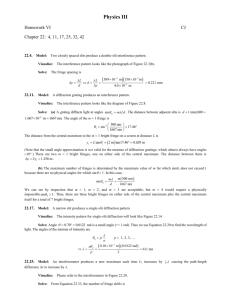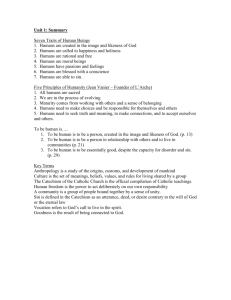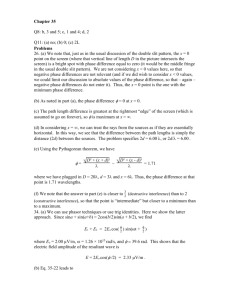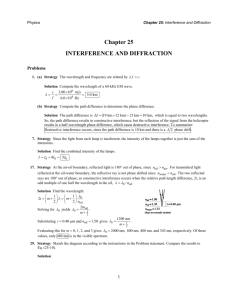Chapter 36: Diffraction 36-15 THINK The relative intensity in a single
advertisement
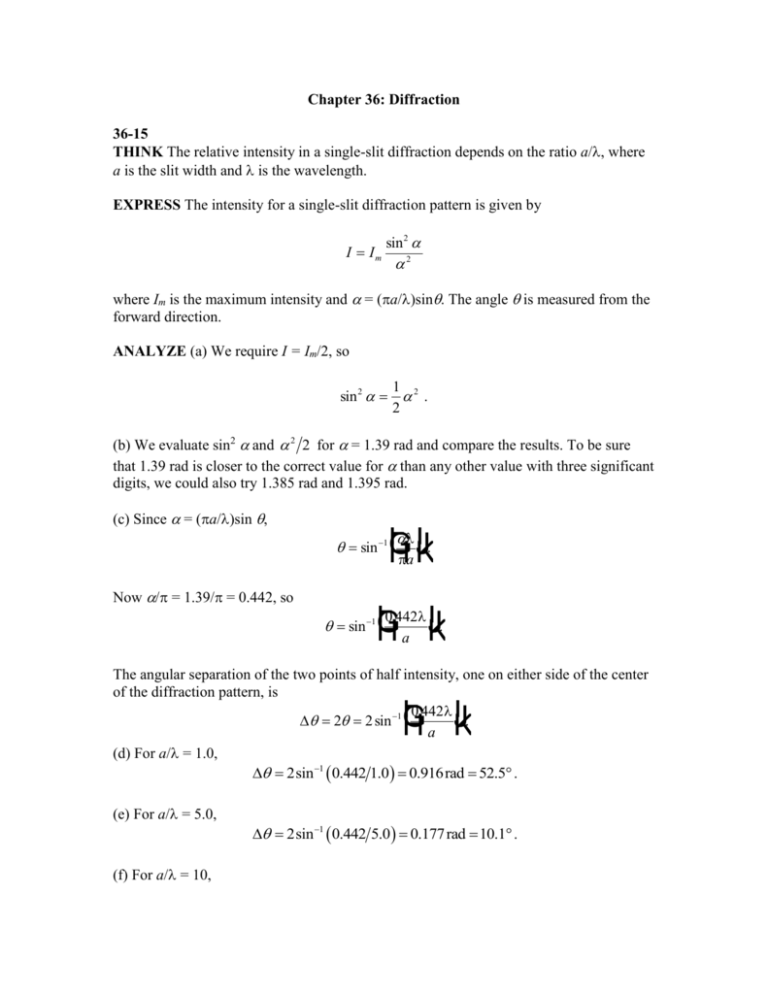
Chapter 36: Diffraction 36-15 THINK The relative intensity in a single-slit diffraction depends on the ratio a/, where a is the slit width and is the wavelength. EXPRESS The intensity for a single-slit diffraction pattern is given by I Im sin 2 2 where Im is the maximum intensity and = (a/)sin. The angle is measured from the forward direction. ANALYZE (a) We require I = Im/2, so 1 sin 2 2 . 2 (b) We evaluate sin2 and 2 2 for = 1.39 rad and compare the results. To be sure that 1.39 rad is closer to the correct value for than any other value with three significant digits, we could also try 1.385 rad and 1.395 rad. (c) Since = (a/)sin , sin 1 Now / = 1.39/ = 0.442, so sin 1 I F G Ha J K. 0.442 I F G Ha J K. The angular separation of the two points of half intensity, one on either side of the center of the diffraction pattern, is 0.442 2 2 sin 1 . a (d) For a/ = 1.0, 2sin 1 0.442 1.0 0.916rad 52.5 . F IJ G H K (e) For a/ = 5.0, (f) For a/ = 10, 2sin 1 0.442 5.0 0.177 rad 10.1 . b g 2 sin 1 0.442 10 0.0884 rad 5.06 . LEARN As shown in Fig. 36-8, the wider the slit is (relative to the wavelength), the narrower is the central diffraction maximum. 36-21 THINK We apply the Rayleigh criterion to estimate the linear separation between the two objects. EXPRESS If L is the distance from the observer to the objects, then the smallest separation D they can have and still be resolvable is D = LR, where R is measured in radians. ANALYZE (a) With small-angle approximation, R 1.22 / d , where is the wavelength and d is the diameter of the aperture. Thus, c hc h . 8.0 1010 m 550 109 m 122 . L 122 D 11 . 107 m = 1.1 104 km . 3 d 5.0 10 m This distance is greater than the diameter of Mars; therefore, one part of the planet’s surface cannot be resolved from another part. (b) Now d = 5.1 m and D 1.22 8.0 1010 m 550 109 m 5.1m 1.1104 m 11 km . LEARN By the Rayleigh criterion for resolvability, two objects can be resolved only if their angular separation at the observer is greater than R 1.22 / d . 36-43 THINK For relatively wide slits, the interference of light from two slits produces bright fringes that do not all have the same intensity; instead, the intensities are modified by diffraction of light passing through each slit. EXPRESS The angular positions of the bright interference fringes are given by d sin = m, where d is the slit separation, is the wavelength, and m is an integer. The first diffraction minimum occurs at the angle 1 given by a sin 1 = , where a is the slit width. The diffraction peak extends from –1 to +1, so we should count the number of values of m for which –1 < < +1, or, equivalently, the number of values of m for which – sin 1 < sin < + sin 1. The intensity at the screen is given by sin I G c hF H J K 2 I I m cos2 where = (a/)sin , = (d/)sin , and Im is the intensity at the center of the pattern. ANALYZE (a) The condition above means – 1/a < m/d < 1/a, or –d/a < m < +d/a. Now d/a = (0.150 10–3 m)/(30.0 10–6 m) = 5.00, so the values of m are m = –4, –3, –2, –1, 0, +1, +2, +3, and +4. There are 9 fringes. (b) For the third bright interference fringe, d sin = 3, so = 3 rad and cos2 = 1. Similarly, = 3a/d = 3/5.00 = 0.600 rad and sin I F sin 0.600 I F G G J H K H0.600 J K 0.255 . 2 2 The intensity ratio is I/Im = 0.255. LEARN The expression for intensity contains two factors: (1) the interference factor cos 2 due to the interference between two slits with separation d, and (2) the diffraction factor [(sin ) / ]2 which arises due to diffraction by a single slit of width a. In the limit a 0, (sin ) / 1, and we recover Eq. 35-22 for the interference between two slits of vanishingly narrow slits separated by d. Similarly, setting d = 0 or equivalently, = 0, we recover Eq. 36-5 for the diffraction of a single slit of width a. A plot of the relative intensity is given below. 36-49 THINK Maxima of a diffraction grating pattern occur at angles given by d sin = m, where d is the slit separation, is the wavelength, and m is an integer. EXPRESS If two lines are adjacent, then their order numbers differ by unity. Let m be the order number for the line with sin = 0.2 and m + 1 be the order number for the line with sin = 0.3. Then, 0.2d = m, 0.3d = (m + 1). ANALYZE (a) We subtract the first equation from the second to obtain 0.1d = , or d = /0.1 = (600 10–9m)/0.1 = 6.0 10–6 m. (b) Minima of the single-slit diffraction pattern occur at angles given by a sin = m, where a is the slit width. Since the fourth-order interference maximum is missing, it must fall at one of these angles. If a is the smallest slit width for which this order is missing, the angle must be given by a sin = . It is also given by d sin = 4, so a = d/4 = (6.0 10–6 m)/4 = 1.5 10–6 m. (c) First, we set = 90° and find the largest value of m for which m < d sin. This is the highest order that is diffracted toward the screen. The condition is the same as m < d/ and since d/ = (6.0 10–6 m)/(600 10–9 m) = 10.0, the highest order seen is the m = 9 order. The fourth and eighth orders are missing, so the observable orders are m = 0, 1, 2, 3, 5, 6, 7, and 9. Thus, the largest value of the order number is m = 9. (d) Using the result obtained in (c), the second largest value of the order number is m = 7. (e) Similarly, the third largest value of the order number is m = 6. LEARN Interference maxima occur when d sin = m, while the condition for diffraction minima is a sin = m. Thus, a particular interference maximum with order m may coincide with the diffraction minimum of order m. The value of m is given by d sin m d m m. a sin m a Since m = 4 when m 1, we conclude that d/a = 4. Thus, m = 8 would correspond to the second diffraction minimum ( m 2 ).


